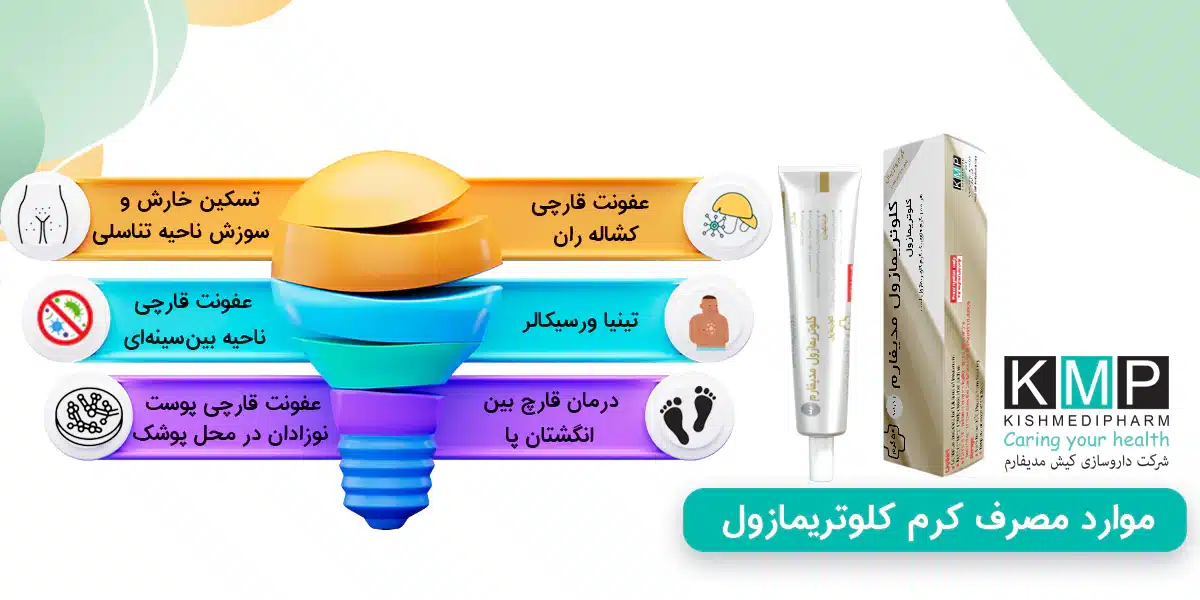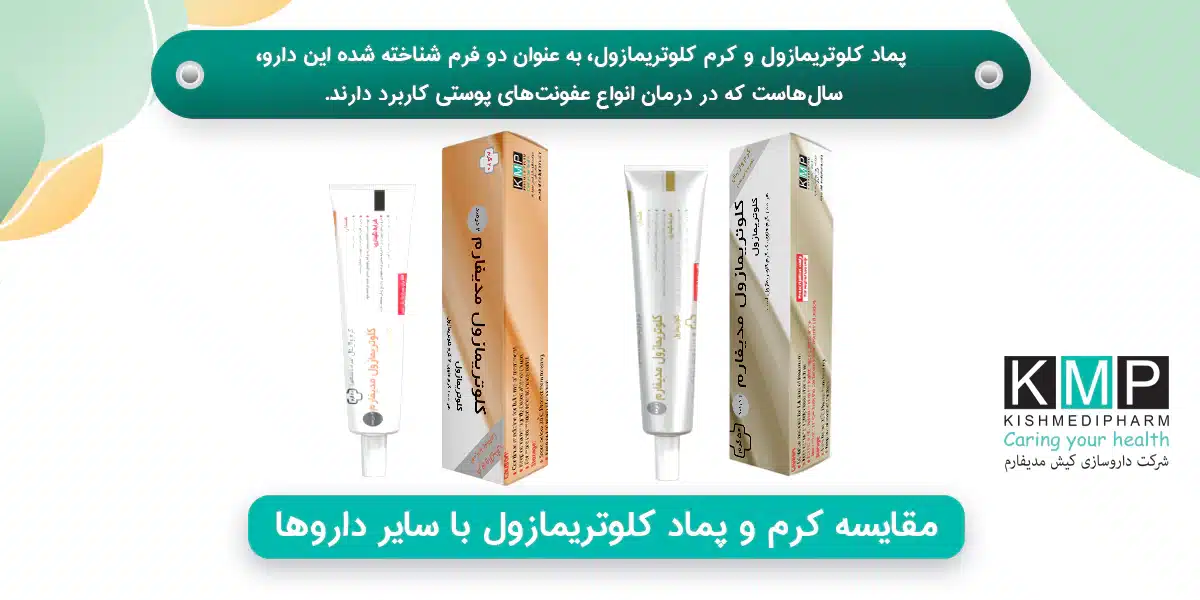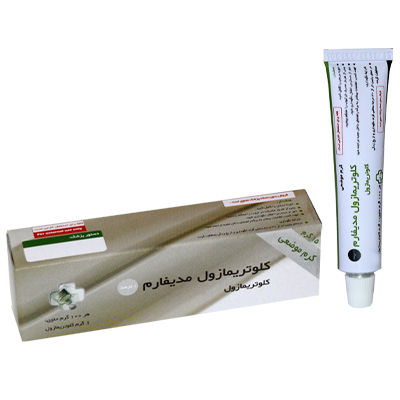Description
Clotrimazole is an antifungal drug from the imidazole family that is commonly used to treat fungal infections. Fungi usually develop between the toes, in the hair, on the skin, and even in the vagina. This drug is produced in the formats of vaginal tablets, vaginal suppositories, lotions, solutions, creams, and clotrimazole ointments. Clotrimazole 1% topical cream is produced by Kish Medipharm Pharmaceutical Company and is easily available and purchased in pharmacies across the country.
The mechanism of action of clotrimazole is by changing the permeability of the fungal cell membrane through binding to phospholipids, which leads to intracellular elements. The main mechanism of clotrimazole is the inhibition of the enzyme lanosterol 14-alpha demethylase, which is involved in the synthesis of ergosterol (a vital component of the fungal cell membrane). In fact, this drug prevents the reproduction of the fungi that have formed, and ultimately eliminates this fungal infection.
Uses of topical clotrimazole 1% cream and ointment
As mentioned, Clotrimazole cream from Medipharm prevents the formation of cell membranes and inhibits the growth and division of fungi by inhibiting the biosynthesis of ergosterol or other sterols, as well as the activity of peroxidase and oxidase enzymes, followed by an increase in the toxic concentration of hydrogen peroxide. In general, Clotrimazole cream from Medipharm is prescribed to you according to the diagnosis and discretion of the doctor, but it is usually recommended for the following cases:

Clotrimazole cream, with its fast absorption, light texture, and non-irritating nature, is a more suitable option for sensitive areas and areas in contact with clothing; while the ointment is more long-lasting and is used in long-term treatments.
- Treatment of vaginal yeast infection or vaginal candidiasis is one of the main reasons for the production of clotrimazole ointment and clotrimazole cream. Also, Kish Medipharm's clotrimazole cream is specifically considered to be suitable for the treatment of vaginal yeast infection, as it has an applicator.
- Athlete's foot, or tinea pedis, is a common and contagious disease. It is called athlete's foot because it is common among athletes. It is usually caused by wearing tight, poorly ventilated shoes or having a pre-existing wound. Also, because it is contagious, other gym members may also get the condition if they are in a place where this type of fungus is present.
- Cutaneous candidiasis is another condition for which clotrimazole cream is prescribed and recommended. Fungal infections can occur in areas of the body that are moist and creased, such as the armpits and groin. This medication is also intended to treat these types of infections.
- Treating fungus between toes: Clotrimazole is effective for treating fungal infections between toes that are caused by moisture or wearing closed shoes.
- Ringworm of the groin (tinea cruris): Clotrimazole ointment is a common option for relieving itching, redness, and inflammation of the groin area caused by fungus.
- Tinea versicolor (ringworm): Clotrimazole is used to treat superficial skin fungi that cause discoloration of areas of the skin.
- Fungal infection of the skin of newborns in the diaper area: If a fungal infection is diagnosed, clotrimazole can help improve inflammation in the diaper area.
- Relieving itching and burning in the external genital area of women: If the cause of itching is fungal, clotrimazole is effective in relieving symptoms.
- Yeast infection of the perineum in women: Areas that are in direct and moist contact are prone to fungal infection, and clotrimazole is prescribed to treat it.
- Fungal infection of the anal and perianal area: Clotrimazole is used to relieve itching, inflammation, and redness caused by fungal infection around the anus.
| Consumption area | Application | Explanation | Common status |
|---|---|---|---|
| Female internal genitalia | Vaginal candidiasis | Treatment of vaginal thrush caused by a fungal infection | Very common |
| Foot (between the toes) | Athlete's foot (tinea pedis) | Eliminate fungus between the toes caused by moisture and closed shoes | Common |
| Crepey skin (groin, armpits) | Cutaneous candidiasis | Treating itching and inflammation in moist areas of the body | Common |
| Legs and groin | Tinea cruris | Treatment of groin fungus caused by sweating and friction | Common |
| Trunk and shoulders | Tinea versicolor (ringworm) | Removal of discolored skin spots caused by superficial fungus | Fairly common |
| Infant diaper area | Diaper rash | Relieves inflammation caused by fungal growth in wet diaper areas | Common in newborns |
| External female genitalia | Genital yeast infection | Relieves itching, redness and burning in case of fungal origin | Common |
| Between the breasts in women | Interstitial fungal infection | Relieving inflammation of moist and sticky areas of skin in women | Common |
| Anal and surrounding area | Candidiasis of the perianal area | Treatment of anal itching and inflammation caused by fungus | Fairly common |
| Whole body | Preventing fungal infection | Frequent use for people with a history of chronic fungal infections | Case-by-case and prescription |
Tips and how to use clotrimazole ointment or cream
Kish Medipharm topical clotrimazole cream is used as an antifungal medication to treat vaginal yeast infections. Given that fungal infections may spread to other parts of the body if hygiene is not observed or if used incorrectly, here are some important points you should know about using clotrimazole cream:
- Washing hands before and after applying clotrimazole cream is essential to prevent the spread of infection.
- Use intravaginally, once (at bedtime).
- Using the tube cap, pierce the aluminum cap and place the applicator over the opening of the tube. Then, fill the applicator with clotrimazole cream to a specified amount and, while lying on your back, insert it as far as possible into the vagina and empty it.
- The treatment period depends on the doctor's opinion, but typically 7 to 10 days are required for treatment.
- It should be noted that if you experience any symptoms such as excessive discharge, burning, itching, vaginal irritation, or severe abdominal pain, consult your doctor and discontinue use of the medication.
- In some rare cases, it has been reported that people may have a severe allergy to clotrimazole, in which case they should not use clotrimazole cream or ointment under any circumstances.
- Using the applicator for virgin women and girls younger than 12 years of age is also a contraindication to the use of this medication.
- Since clotrimazole cream is in pregnancy category B, it should be used under the supervision of a doctor and specialist during breastfeeding and pregnancy.
- This drug is produced by Kish Medipharm Pharmaceutical Company in a 20 and 50 gram tube in doses of 1 and 2 percent, along with an applicator inside the box.
- Clotrimazole cream should be stored below 30°C and protected from freezing.
Simple on the surface, but complex on the inside; nail fungus is one of the most chronic and resistant skin diseases that not only changes the appearance of the nail, but can also lead to pain, brittleness, and even an unpleasant odor. In the meantime, if you've wondered if this problem can be treated with just a topical medication, without the need for complicated oral medications, it's time to draw your attention to a proven solution: clotrimazole cream.
In the world of antifungal treatments, clotrimazole ointment is one of the most well-known options, gaining a special place among doctors and patients due to its high effectiveness, low side effects, and ease of use. But the important question is how to apply clotrimazole cream to the nail to get the most effect? This is exactly where science, precision, and a little patience come together.
Imagine your toenail or fingernail being infested with fungus that has made it thick, yellow, dark, and brittle. You see it every day, you're embarrassed about it every day, and you've probably even tried to hide it with nail polish or a top coat. But the good news is that if you know how to use clotrimazole cream properly, you can stop this microscopic invasion at its source. It's more than just a simple application; it becomes a treatment routine that must be performed with care, consistency, and proper technique.
Clotrimazole ointment gradually penetrates the nail bed and surrounding areas, starting to inhibit the growth of fungi. However, the key to its effectiveness is how the nail surface is prepared, the correct timing of application, and the continuity of treatment. This drug not only affects the infected nail bed, but also penetrates well into the tissue around the nail, preventing the regrowth of the fungus.
How does clotrimazole treat skin infections?
Skin infections are one of the most common and debilitating problems that can significantly affect the quality of life of people. Among them, a drug called clotrimazole has been recognized as one of the most effective treatments that has managed to find a special place in the treatment of fungal skin infections. But the question is; how does clotrimazole treat skin infections and what is the complex mechanism behind this effectiveness?
The first thing to note is the unique and specialized nature of clotrimazole in combating fungi and other pathogens. This drug stops the growth and reproduction process by precisely targeting the cellular structure of fungi. More specifically, clotrimazole prevents the production of ergosterol by inhibiting key enzymes in the fungal cell membrane structure pathway, specifically the enzyme 14-α-demethylase. Ergosterol is an essential and vital component of the fungal cell membrane; without it, the cell membrane is destroyed and the fungi are quickly destroyed.
This clever function allows fungal skin infections to be controlled and treated very quickly and accurately. Therefore, clotrimazole not only speeds up the healing process, but also helps reduce unpleasant symptoms such as itching, inflammation and redness of the skin.
Now, if you are looking for a safe solution to combat fungal infections, using clotrimazole is the best option that can restore the health of your skin. It is recommended to consult a specialist before starting treatment to determine the appropriate dosage and form of the drug for your condition and to prevent side effects.
To achieve healthy skin free from any fungal infection, you should know that choosing the right treatment and knowing how the medicine works is the first and most important step. So, if you are still looking for an effective treatment for your skin infections, it is better to get acquainted with clotrimazole today and benefit from its unique properties.
Advantages of Clotrimazole Cream over Clotrimazole Ointment
Clotrimazole cream and clotrimazole ointment are two types of this medication that are used topically to treat fungal infections, but it should be kept in mind that using the medication in cream form includes benefits that we will discuss below.
The water base of clotrimazole cream allows it to be absorbed into the skin faster and does not leave a trace, so it is more suitable for parts of the body that are in contact with clothing more often. In addition, the water base of this drug does not clog the pores of the skin and does not cause acne and pimples. However, the clotrimazole ointment format does not provide this convenience and may cause acne and pimples on the skin due to its fat base. The ointment form is used for longer duration on the skin and long-term absorption in cases where there is a need for long-term use of the drug.

It should be noted that currently, which medication and dosage is right for you is completely up to your doctor. Obviously, using 2% topical clotrimazole cream is stronger than 1% of the same product and provides a faster response to more severe infections. Before using any medication, be sure to consult your doctor or pharmacist and read the brochures inside the boxes thoroughly. Below are the advantages of clotrimazole cream over clotrimazole ointment:
Faster absorption due to water base
Clotrimazole cream has a water-based formulation, which allows the medication to be absorbed into the skin much more quickly than ointments. This is especially useful in cases where a person does not want a greasy or sticky feeling on the skin.
Suitable for areas in contact with clothing
Because it does not leave a greasy residue and is highly absorbent, cream is a better choice for areas of the body that come into direct contact with clothing. This prevents staining of clothing and provides a more comfortable feeling.
No acne or pimples
The cream formulation does not clog skin pores due to its low fat content, and therefore the likelihood of acne or breakouts is much lower, especially in sensitive or acne-prone skin.
Lighter texture and better feel on the skin
Creams have a softer, lighter texture than ointments and do not leave the skin feeling heavy or greasy after use. This makes people more likely to repeat daily use.
Better absorption in moist areas of the skin
Creams are better absorbed than ointments in moist, sweaty areas such as the armpits, groin, or behind the knees, and they work more effectively in these areas.
Reduces the risk of skin allergies
Due to the cream's simpler and lighter formulation, the likelihood of skin allergies, itching, or inflammation after using it is lower than with clotrimazole ointment. This feature is very important for sensitive and irritable skin.
Cleaner appearance without greasy residue
Creams don't leave a greasy residue after application, while ointments are usually shiny and oily and can leave an undesirable appearance on the skin. Creams have a cleaner, more professional look.
Easier to use during the day
It is easier and more convenient to use the cream when a person is engaged in daily activities, because there is less need to wash the skin before each use and it does not create a sticky feeling.
Overall, clotrimazole cream is considered an optimal option for topical treatments in non-acute conditions due to its light structure, rapid absorption, and convenience in daily use, while clotrimazole ointment is used for longer treatments and chronic cases with longer duration on the skin.
| Feature | Clotrimazole cream | Clotrimazole ointment |
|---|---|---|
| Formulation base | Water base (water-based) | Fat base (oily) |
| Absorption into the skin | Faster, without leaving a greasy residue | Slower absorption, oiliness remaining on the skin |
| Suitable for areas covered by clothing | Very suitable because it does not stain or leave grease on clothes. | Less suitable due to stains and grease on clothes |
| Causes acne and pimples | Least likely to cause acne and pimples | May clog pores and cause acne |
| Texture and feel after use | Light, soft and without a greasy or heavy feel | Greasy, heavy and feels sticky on the skin |
| Effective in moist areas (e.g. armpits) | Better absorption and more effective performance | Less and less appropriate absorption |
| Possibility of skin sensitivity | Less due to lighter formulation | Higher likelihood of sensitivity and inflammation |
| Appearance after use | No greasy residue and cleaner appearance | Shiny and greasy, may create an undesirable appearance |
| Use during the day | Easier and more convenient to use in everyday situations | Less comfortable for repeated use throughout the day |
| Main application | Short-term and non-acute treatments | Long-term and chronic treatments |
Daily dosage of clotrimazole cream
In the complex world of skin treatments, choosing the right medication is only part of the path to recovery; the more important part is how to use the medication correctly and regularly. One of the most widely used drugs in the field of treating fungal infections is clotrimazole cream, which has a special place in the prescriptions of dermatologists and gynecologists due to its high effectiveness, acceptable safety, and easy availability. However, it should be noted that even the most effective drugs may not have the desired results or even lead to drug resistance if used incorrectly or irregularly.
In situations where the patient is experiencing itching, inflammation, redness, or peeling of the skin, paying attention to the daily dosage of clotrimazole cream will not only speed up the healing process, but also prevent the symptoms from returning. Many people mistakenly believe that using more medication means faster healing, while excessive or unprescribed use can lead to skin irritation, excessive dryness, or even allergic reactions.

Whether it is for treating oral thrush, vaginal yeast infections, athlete's foot, tinea versicolor or fungal infections of the skin folds, the correct dosage and regularity of use are key to the success of the treatment. For a better understanding, the following are the common and recommended dosages of clotrimazole cream for various applications. This information is for general purposes only and is not a substitute for medical advice.
- Twice daily for superficial skin infections: Clotrimazole cream is recommended to be applied morning and night to the affected areas for 2 to 4 weeks. The area should be completely clean and dry before application.
- Three times a day for more acute or chronic infections: In some more severe cases, such as chronic candidiasis or resistant interdigital fungi, your doctor may prescribe three times a day.
- Once a night for vaginal infections (with applicator): If clotrimazole ointment or vaginal clotrimazole cream is prescribed, it is usually used once a night before bed, using a special applicator, for 3 to 7 nights.
- A thin layer at each application: There is no need to apply a thick layer of the medicine; just a thin layer of clotrimazole cream is enough for complete absorption and to exert its therapeutic effect.
- Continue treatment for several days after apparent improvement: To prevent symptoms from returning, it is recommended to continue using the cream even for 7 days after the apparent symptoms have resolved, until the fungi are completely eliminated.
- Do not exceed the recommended dose:Increasing the frequency of application or the amount of cream in the hope of faster healing may cause skin dryness, irritation, and local sensitivity.
- Consult a doctor if there is no improvement within 4 weeks: If symptoms persist after 2 to 4 weeks of regular use, it is necessary to consult a doctor again; the type of fungus or drug resistance may have changed.
Strict adherence to these tips when using clotrimazole cream or clotrimazole ointment is the key to achieving an effective, safe and relapse-free treatment. Always remember that discipline, awareness and adherence to medical instructions are an integral part of the success of any drug treatment.
Possible side effects of clotrimazole
Side effects are always a major concern when using any medication. This is especially important for medications such as clotrimazole ointment and clotrimazole cream, which are widely used to treat fungal infections. It should be remembered that although these medications play an effective role in improving and treating diseases, side effects caused by improper use or individual sensitivities can be a cause for serious concern. Accurate and informed recognition of these side effects is the key to preventing and managing the use of these medications properly.
From the moment you decide to use clotrimazole cream, you should keep in mind that no medicine is free from side effects. In fact, these side effects may be mild or severe and include a wide range of skin reactions to systemic problems. This makes it important to consult a specialist and carefully read the medicine leaflet. Although the therapeutic effects of these drugs have been proven, knowing about things like itching, burning, swelling or even allergic reactions can help you use them more safely and effectively.
Those interested in using clotrimazole ointment should know that being aware of the possible side effects of clotrimazole will not only help reduce the risks, but will also increase confidence in the treatment process. With proper understanding and sufficient information, it is possible to quickly identify unusual symptoms and take the necessary measures in a timely manner. The possible side effects of clotrimazole are as follows:
- Itching and inflammation of the skin
- Burning or prickling sensation
- Local redness and swelling
- Dry or flaky skin
- Skin allergies such as hives
- Severe allergic reactions may occur in rare cases.
- Pain or irritation at the application site
- Skin rash
- Burning sensation in surrounding areas
- Skin discoloration at the treatment site
Considering these cases, it is recommended to use clotrimazole cream and clotrimazole ointment under the close supervision of a doctor and in accordance with the instructions to prevent complications and ensure the best possible treatment process. Careful care and information are the first step in protecting skin health and ensuring the effectiveness of these important medications.

Comparing Clotrimazole Cream and Ointment with Other Drugs
In the treatment of fungal infections and some skin conditions, choosing the right medication plays a crucial role in the success of the treatment. Clotrimazole ointment and clotrimazole cream, as the two well-known forms of this drug, have been used for many years to treat a variety of skin infections. However, comparing clotrimazole with other antifungal drugs and similar drugs can provide a more comprehensive and realistic view of the treatment options available to patients and doctors. This review will help you make a more informed and effective choice by understanding the benefits, limitations, and uses of each drug.
Itraconazole:
Itraconazole is a systemic antifungal medication prescribed to treat more serious and deeper infections. Unlike clotrimazole cream, which is mainly used topically, itraconazole is taken orally and can penetrate well into tissues. It is useful for treating more resistant fungi and systemic infections, but it has more side effects than clotrimazole.
Fluconazole:
Fluconazole is a common oral medication used to treat fungal infections. It is particularly effective in treating vaginal and oral fungal infections. Unlike clotrimazole ointment, which is applied topically, fluconazole acts systemically and is rapidly distributed throughout the body. It is a good option for patients with widespread infections.
Terbinafine:
Terbinafine is an antifungal medication with strong antifungal properties that is commonly used to treat fungal infections of the nails and skin. It can be taken topically or orally and is a good alternative in cases where clotrimazole cream is not effective.
Miconazole:
Miconazole is also a topical antifungal medication that comes in cream and spray form. It is commonly used to treat superficial fungal infections and is similar to clotrimazole ointment but fights a wider range of fungi.
Nitrofurantoin:
Although nitrofurantoin is an antibacterial drug and not an antifungal, in some circumstances it is prescribed in combination with antifungal drugs such as clotrimazole cream to prevent combined infections.
Clotrimazole with betamethasone:
The combination of these two drugs in the form of an ointment is used to reduce inflammation and itching associated with fungal infections, but it should be used with caution due to possible side effects from steroids.
Amphotericin B:
Amphotericin B is a potent systemic antifungal drug that is usually used in severe, life-threatening infections. Its use is very limited and requires close medical supervision.
Econazole:
Econazole is another topical medication used to treat fungal skin infections and covers a wide range of fungi. It works similarly to clotrimazole cream, but may cause different side effects in some patients.
Ciclopirox:
This medication is available in the form of nail polish, cream, and lotion, and in addition to being antifungal, it also has anti-inflammatory properties. It is used in cases where clotrimazole cream does not respond adequately to treatment.

A detailed understanding of these medications and their comparison with clotrimazole ointment and clotrimazole cream will help you make the right choice and increase the effectiveness of the treatment. It is always recommended to consult a specialist before starting any treatment to choose the best and safest option based on your specific conditions.
| Drug name | Type of consumption | Main application | Advantages over clotrimazole | Limitations/Possible Complications |
|---|---|---|---|---|
| Clotrimazole cream | Local | Superficial fungal infections of the skin and vagina | Fast absorbing, non-greasy, suitable for sensitive skin | Needs to be taken regularly several times a day |
| Clotrimazole ointment | Local | Chronic fungal infections or dry areas of skin | Longer lasting on the skin, suitable for dry areas | Oiliness, possibility of acne |
| Itraconazole | Edible | Systemic and severe fungal infections | Deep penetration, effective against resistant fungi | Liver complications, high drug interactions |
| Fluconazole | Edible | Vaginal and oral infections | Faster effect, lower dosage | Causes nausea, risk of interactions with other medications |
| Terbinafine | Topical/Oral | Nail and skin infections | High effectiveness against dermatophytes | May cause irritation on dry skin. |
| Miconazole | Local | Superficial fungal infections | Broader antifungal spectrum than clotrimazole | Local irritation in some patients |
| Nitrofurantoin | Edible | Urinary tract infections (antibacterial) | In combination with clotrimazole for combination therapy | Only for bacteria, not fungi |
| Clotrimazole + Betamethasone | Local | Fungal infection with inflammation | Immediate relief of itching and inflammation | Side effects of steroids in long-term use |
| Amphotericin B | Injectable | Dangerous systemic fungal infections | High potency in life-threatening infections | Severe nephrotoxicity, only in certain circumstances |
| Econazole | Local | Superficial skin infections | Broad spectrum antifungal similar to clotrimazole | Skin irritation in some cases |
| Ciclopirox | Local | Fungal infections | Anti-inflammatory properties while being antifungal | Slower effectiveness in some patients |
How to properly store clotrimazole
Proper storage of medications, especially topical medications such as clotrimazole ointment and clotrimazole cream, plays a vital role in maintaining their effectiveness and safety. Improper use or improper storage of these medications can lead to reduced quality, altered therapeutic properties, and even unwanted side effects. Therefore, a thorough understanding of the principles and methods of clotrimazole storage is essential and should not be underestimated.
The storage environment for these medications should be free from humidity and high temperatures, as adverse environmental factors can affect the chemical structure and antifungal potency of the medication. For example, placing clotrimazole cream or ointment near heat sources such as a radiator or direct sunlight can cause them to change color and reduce their effectiveness. Also, storing these medications in the refrigerator is usually not recommended unless directed to do so by a doctor or pharmacist.
On the other hand, the primary packaging of the drug, which is carefully designed, must remain undamaged to prevent contamination. Using tight caps and observing cleanliness during use are important points in maintaining the quality of these drugs. Paying attention to the expiration date and not using expired drugs are also basic principles in the proper storage of clotrimazole ointment and clotrimazole cream.
Ultimately, following these guidelines not only helps maintain the consumer's health, but also ensures that the desired treatment results are achieved. It is recommended that you always pay special attention to medication instructions and consult with pharmaceutical experts for more detailed information and expert guidance.

Important warnings about using clotrimazole cream or ointment
From skin allergies to drug interactions, each of these warnings plays an important role in managing your treatment. Here, in addition to explaining the importance of following the warnings, a list of the most important safety tips for using clotrimazole ointment and clotrimazole cream is provided, which are essential to pay attention to. Important warnings for using clotrimazole are as follows:
- Avoid using the medication on open wounds or irritated skin, as it may worsen inflammation and sensitivity.
- If you experience any allergic symptoms such as severe itching, swelling, or excessive redness, stop taking the medication immediately and consult a doctor.
- Avoid contact with eyes, mouth, or mucous membranes; in case of accidental contact, rinse the area with plenty of water.
- Concomitant use of clotrimazole ointment or clotrimazole cream with other medications without consulting a doctor can cause drug interactions.
- Taking medication during pregnancy or breastfeeding should be done under the close supervision of a doctor to avoid possible complications.
- For children and the elderly, the dosage and duration of use should be adjusted with caution and under medical supervision.
- Frequent and excessive use of the medication may lead to fungal resistance and reduced effectiveness, so follow your doctor's instructions carefully.
- Avoid storing the medicine in hot and humid environments to maintain the quality and effectiveness of clotrimazole cream and clotrimazole ointment.
Strict adherence to these warnings is the first step to ensuring a successful and problem-free treatment process. Never take this medication without full knowledge and expert advice to best protect your health.

Use of clotrimazole in pregnant or breastfeeding women and children; yes or no?
The child's body, especially in the first years of life, has a different structure than adults; thinner skin, faster absorption rate and greater reactivity. These characteristics make the use of any topical medication, even those that seem safe for adults, more cautious. Clotrimazole can be prescribed to children in special cases and with the doctor's diagnosis, but the dose, duration of use and area of use must be carefully determined. Although this drug is listed in many medical guidelines as a safe drug for children over two years of age, it should not be forgotten that arbitrary use without consulting a doctor can lead to skin irritation, excessive dryness or even allergic reactions.
Pregnancy and breastfeeding are two very sensitive and complex stages in every woman's life; periods in which even the simplest medications can have profound effects on the health of the mother and the fetus or infant. In such circumstances, choosing a topical medication such as clotrimazole to treat fungal infections may raise many concerns: Is it safe to use this medication during pregnancy? What about during breastfeeding? Is there a possibility of systemic absorption and effects on the fetus or breast milk?
Clotrimazole is a topical antifungal medication. Can clotrimazole be used during pregnancy, breastfeeding, and for children? Safety review, usage tips, and the importance of medical advice before use.
It is widely used and is usually prescribed to treat superficial infections such as vaginal candidiasis or skin infections. However, it should be noted that during pregnancy, the female body undergoes extensive changes in metabolism, drug absorption, and skin sensitivities. Limited clinical studies have shown that topical use of clotrimazole during pregnancy, especially in the second and third trimesters, is generally safe; however, its vaginal use in the first trimester of pregnancy should only be done with a doctor's prescription and in special circumstances.
During breastfeeding, since the systemic absorption of this drug from the skin or vagina is very small, the possibility of it entering breast milk and affecting the baby is estimated to be very low. However, it is essential to observe safety precautions such as not using the drug in the breast area or washing it thoroughly before breastfeeding. Pregnancy and breastfeeding are one of the most sensitive and vital stages in every mother's life.
During this period, even the simplest medication can have long-term effects on the health of the fetus or newborn. Therefore, it is strongly recommended not to take any medication, including topical medications such as clotrimazole, without consulting a doctor. Awareness is the key to protecting your health and that of your child. If you want to read everything you need to know about using clotrimazole during pregnancy and breastfeeding, click on the link below:
🔗 mothertobaby.org/fact-sheets/clotrimazole



Ayda –
Excellent effect